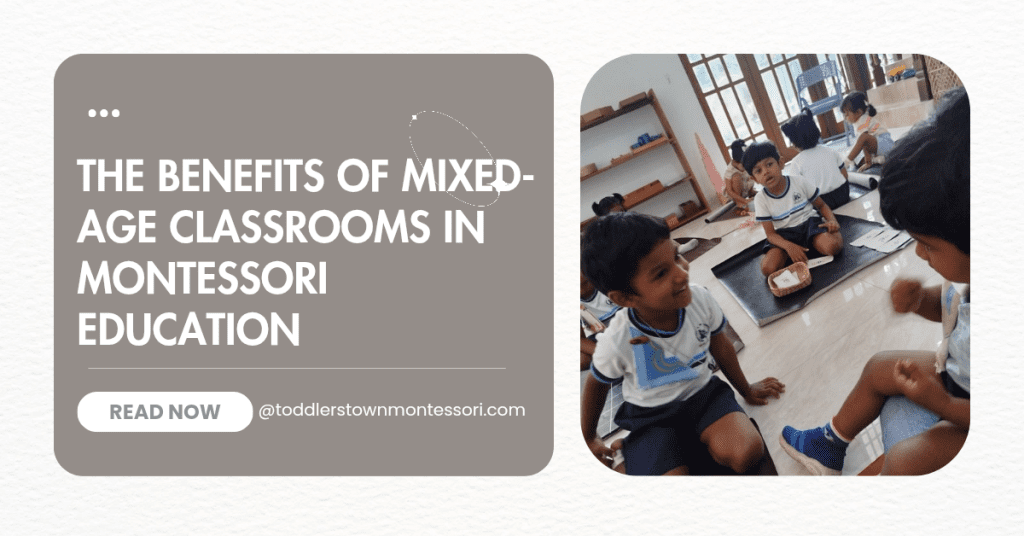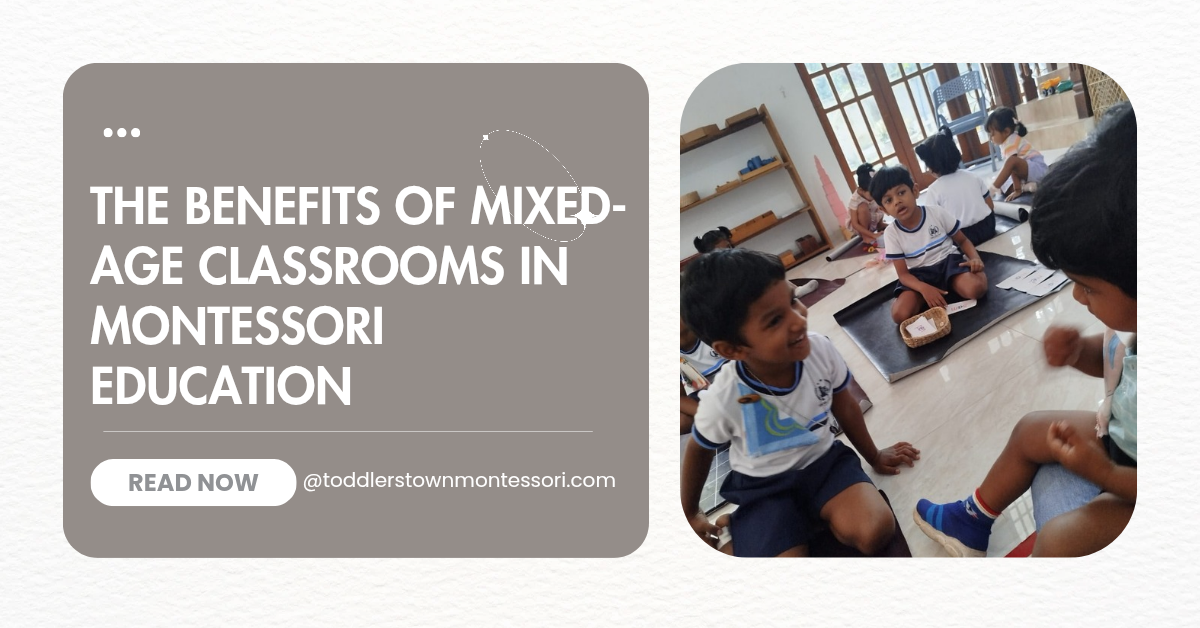- Written by: Nathaliya Perera
- April 28, 2025
- Categories: Montessori Education
- Tags: , AMI, AMI Montessori Sri Lanka, best Montessori school in Kandana, early childhood education Montessori, Montessori Method, Montessori method for toddlers, Montessori mixed-age classrooms, Toddlers Town Montessori House of Children

At Toddlers Town Montessori House of Children in Kandana, we follow the world-renowned AMI Montessori Method — and one of the unique features parents often ask us about is our mixed-age classrooms. Why do we group children of different ages together instead of keeping them strictly by year?
The answer lies at the heart of Montessori philosophy, and today we’ll explain why mixed-age learning environments truly work wonders for young children’s development.
Encourages Natural Learning from Peers
In a Montessori mixed-age classroom, younger children naturally look up to their older peers. They observe more advanced activities and are inspired to try new skills. Meanwhile, older children develop leadership qualities by helping the younger ones.
This peer-to-peer learning creates a nurturing community where children learn not just from the teacher, but from each other. Younger students gain exposure to more complex concepts through observation before formal introduction, while older students reinforce their own knowledge by teaching others.
As Dr. Maria Montessori observed, “The main thing is that the groups should contain different ages, because it has great influence on the cultural development of the child. This is obtained by the relations of the children among themselves.”
Promotes Independence and Confidence
When children stay in the same environment for 2–3 years (typically from ages 2.5 to 6), they build a strong sense of belonging and ownership. They become comfortable with their environment, materials, and routines, which promotes greater independence and self-confidence.
At Toddlers Town Montessori, we often see a shy two-year-old blossom into a confident, capable five-year-old who proudly leads by example. This transformation happens naturally as children experience the complete cycle from newcomer to experienced classroom member.
Supports Individualized Learning
Every child develops at their own pace. In a mixed-age classroom, there’s no pressure to “catch up” or “wait” for others. The Montessori method allows children to work on activities that match their unique level of readiness, not just their age.
This individualized approach honors what Montessori called “sensitive periods” – specific windows when children are naturally receptive to developing particular skills. In our mixed-age environment, children can fully engage with materials that match their current developmental needs, fostering deeper concentration and genuine mastery.
Builds Stronger Social and Emotional Skills
In mixed-age settings, children naturally practice patience, empathy, cooperation, and conflict resolution. They experience being both the “youngest” and the “oldest” in the group during their time in the classroom, helping them develop emotional intelligence that lasts a lifetime.
The classroom becomes a family-style community where children learn to:
- Help others with genuine care
- Wait patiently when someone else needs attention
- Resolve differences respectfully
- Celebrate the achievements of their peers
These vital social skills develop organically in our mixed-age environment at Toddlers Town Montessori, preparing children for success far beyond academics.
Reduces Competition, Enhances Collaboration
Unlike traditional single-age classrooms where children often compare themselves to peers, mixed-age groupings naturally reduce unhealthy competition. Children aren’t all working on identical tasks at the same time, removing the pressure to perform at exactly the same level.
Instead, our environment fosters collaboration where children help each other based on skill and interest rather than age. This creates a community of learners who value cooperation over competition – a mindset that serves them well throughout life.
Mirrors Real-World Communities
Outside of school, children will rarely be grouped by exact age. Families, neighborhoods, and workplaces all involve a variety of ages and abilities. A mixed-age Montessori classroom mirrors this natural structure, preparing children for real-world situations where they collaborate, lead, and learn from those older and younger than themselves.
This authentic social environment helps children develop flexibility, adaptability, and the ability to work with diverse groups – essential skills for success in today’s interconnected world.
Discover the Montessori Difference at Toddlers Town
At Toddlers Town Montessori House of Children, we are proud to offer an authentic AMI Montessori experience in a warm, nurturing environment. Our mixed-age classrooms support the development of the whole child – intellectually, socially, emotionally, and physically.
We invite you to visit our school and observe our mixed-age classrooms in action. See for yourself how this thoughtfully designed approach creates confident, capable, and compassionate learners who are well-prepared for future success.
Contact us today to schedule a tour and learn more about how the Montessori method can benefit your child.








